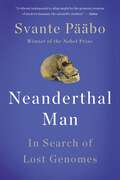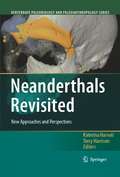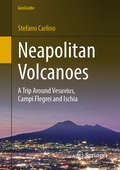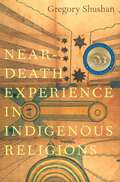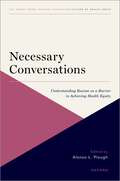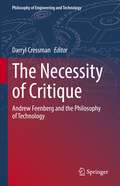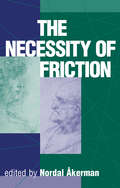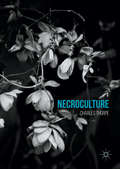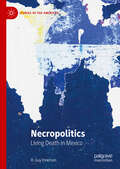- Table View
- List View
Neanderthal Man: In Search of Lost Genomes
by Svante PääboA preeminent geneticist hunts the Neanderthal and Denisovan genomes to answer the biggest question of them all: how did our ancestors become human?Neanderthal Man tells the riveting personal and scientific story of the quest to use ancient DNA to unlock the secrets of human evolution. Beginning with the study of DNA in Egyptian mummies in the early 1980s and culminating in the sequencing of the Neanderthal genome in 2010, Neanderthal Man describes the events, intrigues, failures, and triumphs of these scientifically rich years through the lens of the pioneer and inventor of the field of ancient DNA. We learn that Neanderthal genes offer a unique window into the lives of our ancient relatives and may hold the key to unlocking the mysteries of where language came from as well as why humans survived while Neanderthals went extinct. Pääbo redrew our family tree and permanently changed the way we think about who we are and how we got here. For readers of Richard Dawkins, David Reich, and Hope Jahren, Neanderthal Man is the must-read account of how he did it.
Neanderthal Man: In Search of Lost Genomes
by Svante PääboA preeminent geneticist, winner of the 2022 Nobel Prize in medicine, hunts the Neanderthal and Denisovan genomes to answer the biggest question of them all: how did our ancestors become human?Neanderthal Man tells the riveting personal and scientific story of the quest to use ancient DNA to unlock the secrets of human evolution. Beginning with the study of DNA in Egyptian mummies in the early 1980s and culminating in the sequencing of the Neanderthal genome in 2010, Neanderthal Man describes the events, intrigues, failures, and triumphs of these scientifically rich years through the lens of the pioneer and inventor of the field of ancient DNA, Svante Pääbo. We learn that Neanderthal genes offer a unique window into the lives of our ancient relatives and may hold the key to unlocking the mysteries of where language came from as well as why humans survived while Neanderthals went extinct. Pääbo redrew our family tree and permanently changed the way we think about who we are and how we got here. For readers of Richard Dawkins, David Reich, and Hope Jahren, Neanderthal Man is the must-read account of how he did it.
Neanderthals Revisited: New Approaches and Perspectives (Vertebrate Paleobiology and Paleoanthropology)
by Katerina Harvati Terry HarrisonThis volume presents the cutting-edge research of leading scientists, re-examining the major debates in Neanderthal research with the use of innovative methods and exciting new theoretical approaches. Coverage includes the re-evaluation of Neanderthal anatomy, inferred adaptations and habitual activities, developmental patterns, phylogenetic relationships, and the Neanderthal extinction; new methods include computer tomography, 3D geometric morphometrics, ancient DNA and bioenergetics. The book offers fresh insight into both Neanderthals and modern humans.
Neapolitan Volcanoes: A Trip Around Vesuvius, Campi Flegrei and Ischia (GeoGuide)
by Stefano CarlinoThis book serves as a guide to discovering the most interesting volcano sites in Italy. Accompanied by some extraordinary contemporary images of active Neapolitan volcanoes, it explains the main volcanic processes that have been shaping the landscape of the Campania region and influencing human settlements in this area since Greek and Roman times and that have prompted leading international scientists to visit and study this natural volcanology laboratory. While volcanology is the central topic, the book also addresses other aspects related to the area’s volcanism and is divided into three sections: 1) Neapolitan volcanic activity and processes (with a general introduction to volcanology and its development around Naples together with descriptions of the landscape and the main sites worth visiting); 2) Volcanoes and their interactions with local human settlements since the Bronze Age, recent population growth and the transformation of the territory; 3) The risks posed by Neapolitan Volcanoes, their recent activity and the problem of forecasting any future eruption.
Near and Far Waters: The Geopolitics of Seapower
by Colin FlintSeapower has been a constant in world politics, a tool through which powerful countries have policed the seas for commercial advantage. Political geographer Colin Flint highlights the geography of seapower as a dynamic, continual struggle to gain control of near waters—those parts of the oceans close to a country's shoreline—and far waters—parts of the oceans beyond the horizon and that neighbor the shorelines of other countries. A forceful and clarifying challenge to conventional accounts of geopolitics, Near and Far Waters offers an accessible introduction to the combination of economic and political relations that are the reason behind, and the result of, the development of seapower to control near waters and project force into far waters. Examining the histories of three naval powers (the Netherlands, Britain, and the United States), this book distills the past and present patterns of seapower and their tendency to trigger repercussive conflict and war. Readers will gain an appreciation for how geopolitics works, the importance of seapower in economic competition, the motivations behind China's desire to become a global naval force, and the risks of current and future wars. Drawing on decades of experience, Flint urges readers to take seriously the dilemma of near/far waters as a context for an alternative understanding of global politics.
Near and Far Waters: The Geopolitics of Seapower
by Colin FlintSeapower has been a constant in world politics, a tool through which powerful countries have policed the seas for commercial advantage. Political geographer Colin Flint highlights the geography of seapower as a dynamic, continual struggle to gain control of near waters—those parts of the oceans close to a country's shoreline—and far waters—parts of the oceans beyond the horizon and that neighbor the shorelines of other countries. A forceful and clarifying challenge to conventional accounts of geopolitics, Near and Far Waters offers an accessible introduction to the combination of economic and political relations that are the reason behind, and the result of, the development of seapower to control near waters and project force into far waters. Examining the histories of three naval powers (the Netherlands, Britain, and the United States), this book distills the past and present patterns of seapower and their tendency to trigger repercussive conflict and war. Readers will gain an appreciation for how geopolitics works, the importance of seapower in economic competition, the motivations behind China's desire to become a global naval force, and the risks of current and future wars. Drawing on decades of experience, Flint urges readers to take seriously the dilemma of near/far waters as a context for an alternative understanding of global politics.
Near-Death Experience in Indigenous Religions
by Gregory ShushanNear-death experiences are known around the world and throughout human history. They are sometimes reported by individuals who have revived from a period of clinical death or near-death and they typically feature sensations of leaving the body, entering and emerging from darkness, meeting deceased friends and relatives, encountering beings of light, judgment of one's earthly life, feelings of oneness, and reaching barriers, only to return to the body. Those who have NDEs almost invariably understand them as having profound spiritual or religious significance. In this book, Gregory Shushan explores the relationship between NDEs, shamanism, and beliefs about the afterlife in traditional indigenous societies in Africa, North America, and Oceania. Drawing on historical accounts of the earliest encounters with explorers, missionaries, and ethnologists, this study addresses questions such as: Do ideas about the afterlife commonly originate in NDEs? What role does culture play in how people experience and interpret NDEs? How can we account for cross-cultural similarities and differences between afterlife beliefs? Though NDEs are universal, Shushan shows that how they are actually experienced and interpreted varies by region and culture. In North America, they were commonly valorized, and attempts were made to replicate them through shamanic rituals. In Africa, however, they were largely considered aberrational events with links to possession or sorcery. In Oceania, Micronesia corresponded more to the African model, while Australia had a greater focus on afterlife journey shamanism, and Polynesia and Melanesia showed an almost casual acceptance of the phenomenon as reflected in numerous myths, legends, and historical accounts. This study examines the continuum of similarities and differences between NDEs, shamanism, and afterlife beliefs in dozens of cultures throughout these regions. In the process, it makes a valuable contribution to our knowledge about the origins of afterlife beliefs around the world and the significance of related experiences in human history.
Near-Death Experience in Indigenous Religions
by Gregory ShushanNear-death experiences are known around the world and throughout human history. They are sometimes reported by individuals who have revived from a period of clinical death or near-death and they typically feature sensations of leaving the body, entering and emerging from darkness, meeting deceased friends and relatives, encountering beings of light, judgment of one's earthly life, feelings of oneness, and reaching barriers, only to return to the body. Those who have NDEs almost invariably understand them as having profound spiritual or religious significance. In this book, Gregory Shushan explores the relationship between NDEs, shamanism, and beliefs about the afterlife in traditional indigenous societies in Africa, North America, and Oceania. Drawing on historical accounts of the earliest encounters with explorers, missionaries, and ethnologists, this study addresses questions such as: Do ideas about the afterlife commonly originate in NDEs? What role does culture play in how people experience and interpret NDEs? How can we account for cross-cultural similarities and differences between afterlife beliefs? Though NDEs are universal, Shushan shows that how they are actually experienced and interpreted varies by region and culture. In North America, they were commonly valorized, and attempts were made to replicate them through shamanic rituals. In Africa, however, they were largely considered aberrational events with links to possession or sorcery. In Oceania, Micronesia corresponded more to the African model, while Australia had a greater focus on afterlife journey shamanism, and Polynesia and Melanesia showed an almost casual acceptance of the phenomenon as reflected in numerous myths, legends, and historical accounts. This study examines the continuum of similarities and differences between NDEs, shamanism, and afterlife beliefs in dozens of cultures throughout these regions. In the process, it makes a valuable contribution to our knowledge about the origins of afterlife beliefs around the world and the significance of related experiences in human history.
The Near East: Archaeology in the 'Cradle of Civilization'
by Charles Keith MaiselsThe transition from foraging, farming and the neolithic village to the city-state is a complex and fascinating period. Studies on the prehistory of the Near East by nineteenth and twentieth century pioneers in the field transformed archaeology through the creation of the 'Ages System' of Stone, Bronze and Iron. The Near East provides a developmental account of this period contextualised by discussion of the emergence of archaeology as a discipline.The Near East details the causes and effects - enviromental, organizational, demographic and technological - of the world's first village farming cultures some eight thousand years ago. Charles Maisels explains how cities such as Uruk and Ur, Nippur and Kish formed as a result of geological factors and the role of key organizational features of Sumerian society in introducing the world's first script, system of calculation and literature.
The Near East: Archaeology in the 'Cradle of Civilization' (Experiences Of Archaeology Ser.)
by Charles Keith MaiselsThe transition from foraging, farming and the neolithic village to the city-state is a complex and fascinating period. Studies on the prehistory of the Near East by nineteenth and twentieth century pioneers in the field transformed archaeology through the creation of the 'Ages System' of Stone, Bronze and Iron. The Near East provides a developmental account of this period contextualised by discussion of the emergence of archaeology as a discipline.The Near East details the causes and effects - enviromental, organizational, demographic and technological - of the world's first village farming cultures some eight thousand years ago. Charles Maisels explains how cities such as Uruk and Ur, Nippur and Kish formed as a result of geological factors and the role of key organizational features of Sumerian society in introducing the world's first script, system of calculation and literature.
Near Eastern Culture and Society
by Theodore Cuyler YoungEleven scholars present a broad survey of Arabic-Islamic culture and society in the Near East. Art, literature, science, philosophy, religion, politics, international relations, and social problems are considered.Originally published in 1966.The Princeton Legacy Library uses the latest print-on-demand technology to again make available previously out-of-print books from the distinguished backlist of Princeton University Press. These editions preserve the original texts of these important books while presenting them in durable paperback and hardcover editions. The goal of the Princeton Legacy Library is to vastly increase access to the rich scholarly heritage found in the thousands of books published by Princeton University Press since its founding in 1905.
A Nearly Normal Life: A Memoir
by Charles L. MeeIn the summer of 1953 the author was a carefree, athletic boy of fourteen. But after he collapsed during a school dance one night, he was suddenly bedridden, drifting in & out of consciousness, as his body disintegrated into a shadow of its former self. He had been stricken with spinal polio. When he emerged from the grip of the disease, he was confronted with a life change so enormous that it challenged all he had believed in & forced him, despite his young age, to redefine himself. His once stereotypically normal life, filled with baseball & swimming pools & dreams of girls, had been irreversibly altered. He was almost the same person he had been; he was nearly normal. His moving personal narrative is a textured portrait of life in the fifties - a time when America & her fighting spirit collided with this disease. Both funny & profound, he is a gifted, unique writer, who unravels the mysteries of youth in a Cold War climate, who gives voice to the mind of a child with a potentially fatal disease, & whose recognition of himself as a disabled outsider heightens his brilliant talents as a storyteller.
The NEBI YEARBOOK 1999: North European and Baltic Sea Integration
by P. Joenniemi A. Östhol K. Peschel C. E. StalvantThorvald Stoltenberg Ambassador Chairman of the Editorial Advisory Board A.5 the second volume of the this yearbook goes to press, Europe faces new and to some degree unexpected dangers of political and ideological division. It is a frightening realisation that not even ten years after the fall of the Berlin Wall, the subsequent dissolution of the Soviet Empire and the democratisation and economic transformation of most of the old Soviet-dominated Central and Eastern Europe, fissures have appeared that threaten to undo some of what has been accomplished in terms of East-West rapprochement. The immediate crisis over Kosovo may well have been resolved by the time this is being read. However, it is hard to escape a foreboding that some of the mutual ill will between Russia and the Western powers that has surfaced in the wake of that conflict may linger for years to come. It is therefore imperative that Russia and the Western powers sit down to discuss what can be done to avoid similar conflicts in the future and how to overcome mutual recriminations so that they do not harden into new political front lines between East and West in Europe. The recent developments make the promotion of integration in the NEBI area even more urgent. So far this process has been based on two equally impor tant platforms: economic integration and political integration, including mea sures to dismantle old conflict potentials.
The NEBI YEARBOOK 2003: North European and Baltic Sea Integration
by Pertti Joenniemi Heikki Eskelinen Karin Peschel Carl-Einar StalvantBjllrn Tore Godal Norwegian Ambassador to Germany Chairman of the Editorial Advisory Board Several of the contributions to the present volume of The NEBI Yearbook have been inspired by the fact that roughly speaking, ten years have passed since the first steps were taken to initiate cross-border co-operation in the Barents and Baltic Sea areas. One of the most important co-operative organisations in the European Northeast, i. e. The Council of the Baltic Sea States, was launched in 1992. The Barents Euro Arctic Council was established in 1993. An avalanche of co-operative and cross-border initiatives has since hit this part of Europe with all kinds of actors participating - states, regional and municipal authorities, univer sities, national organisations, businesses and private interests. Even international organisations and actors from outside the immediate NEBI area have taken a special interest in this dynamic part of the world. Among the most important is the European Union, whose Finnish-inspired Northern Dimension initiative has become a permanent fixture. As many of the chapters in NEBI 2003 testifY, integration in the NEB I area - across old political and ideological borders and cultural and socio-economic divides that are among the most pronounced anywhere in the world - has on the whole been a great success.
Necessary Conversations: Understanding Racism as a Barrier to Achieving Health Equity (Culture of Health)
by Alonzo L. PloughThis is an open access title available under the terms of a CC BY-NC-ND 4.0 International license. It is free to read at Oxford Scholarship Online and offered as a free PDF download from OUP and selected open access locations. Necessary Conversations: Understanding Racism as a Barrier to Achieving Health Equity reflects the conviction that a true prioritization of health in our communities is impossible without a commitment to racial equity. Drawing on the pivotal social events of 2020 in America, it extends a powerful call to action based on a growing body of evidence that racism is the underlying cause of so many poor health outcomes. Contributors across health, education, law, and media further the longstanding work of the Robert Wood Johnson Foundation to create a "Culture of Health" by engaging in authentic discussions about the systems and structures that harm people of color and offering provocative ideas and strategies to inspire action. Necessary Conversations ultimately highlights the importance of building leadership and partnerships through those who are most affected in the community. It considers what it would take to overhaul institutions that treat people differently on the basis of race and recognizes that we all must share resources and join together to support the advancement of health and racial equity.
Necessary Illusions: Thought Control in Democratic Societies (The CBC Massey Lectures)
by Noam ChomskyIn his national bestselling 1988 CBC Massey Lectures, Noam Chomsky inquires into the nature of the media in a political system where the population cannot be disciplined by force and thus must be subjected to more subtle forms of ideological control. Specific cases are illustrated in detail, using the U.S. media primarily but also media in other societies. Chomsky considers how the media might be democratized (as part of the general problem of developing more democratic institutions) in order to offer citizens broader and more meaningful participation in social and political life.
Necessary Trouble: Americans in Revolt
by Sarah JaffeNecessary Trouble is the definitive book on the movements that are poised to permanently remake American politics. We are witnessing a moment of unprecedented political turmoil and social activism. Over the last few years, we've seen the growth of the Tea Party, a twenty-first-century black freedom struggle with BlackLivesMatter, Occupy Wall Street, and the grassroots networks supporting presidential candidates in defiance of the traditional party elites.Sarah Jaffe leads readers into the heart of these movements, explaining what has made ordinary Americans become activists. As Jaffe argues, the financial crisis in 2008 was the spark, the moment that crystallized that something was wrong. For years, Jaffe crisscrossed the country, asking people what they were angry about, and what they were doing to take power back. She attended a people's assembly in a church gymnasium in Ferguson, Missouri; walked a picket line at an Atlanta Burger King; rode a bus from New York to Ohio with student organizers; and went door-to-door in Queens days after Hurricane Sandy.From the successful fight for a 15 minimum wage in Seattle and New York to the halting of Shell's Arctic drilling program, Americans are discovering the effectiveness of making good, necessary trouble. Regardless of political alignment, they are boldly challenging who wields power in this country.
Necessary Trouble: Americans in Revolt
by Sarah JaffeNecessary Trouble is the definitive book on the movements that are poised to permanently remake American politics. We are witnessing a moment of unprecedented political turmoil and social activism. Over the last few years, we've seen the growth of the Tea Party, a twenty-first-century black freedom struggle with BlackLivesMatter, Occupy Wall Street, and the grassroots networks supporting presidential candidates in defiance of the traditional party elites. Sarah Jaffe leads readers into the heart of these movements, explaining what has made ordinary Americans become activists. As Jaffe argues, the financial crisis in 2008 was the spark, the moment that crystallized that something was wrong. For years, Jaffe crisscrossed the country, asking people what they were angry about, and what they were doing to take power back. She attended a people's assembly in a church gymnasium in Ferguson, Missouri; walked a picket line at an Atlanta Burger King; rode a bus from New York to Ohio with student organizers; and went door-to-door in Queens days after Hurricane Sandy. From the successful fight for a 15 minimum wage in Seattle and New York to the halting of Shell's Arctic drilling program, Americans are discovering the effectiveness of making good, necessary trouble. Regardless of political alignment, they are boldly challenging who wields power in this country.
The Necessity of Critique: Andrew Feenberg and the Philosophy of Technology (Philosophy of Engineering and Technology #41)
by Darryl CressmanThe essays in this edited collection are inspired by Andrew Feenberg’s philosophy of technology. Feenberg is the leading critical theorist of technology working today, combining the critical traditions of Karl Marx, Martin Heidegger, Georg Lukáacs, and Herbert Marcuse with empirical methods from science & technology studies (STS) and media studies.Divided into three parts, these contributions from philosophers, media theorists, design theorists, and STS scholars, reflect the relevancy of Feenberg's philosophy for making sense of our technically mediated society. This collection appeals to students and researchers interested in the philosophy of technology, critical theory, smart cities, big data, AI, and algorithmic culture.
The Necessity Of Friction
by Nordal AkermanFriction is what keeps us from realizing our goals. It is what compromises all of our plans, sometimes making them unrecognizable. It defies our wish for perfection and constantly surprises us with new elements of resistance. It constitutes the divide between dream and reality.But friction is also what gets us moving, a necessary incentive to achieve progress. Nothing can start if it cannot push off something else. By blocking or delaying the easy solution, friction makes for a richer, more varied world. If it stops schemes from being completely fulfilled, it also stops them form going totally awry.To the modernist project, with its one-sided rationalist pretensions, friction is unambiguously bad?and so it is being disposed of at an increasing speed. The currency markets are one example, cyberspace another. This means less and less time to pause and rethink, while the vulnerability of societies is aggravated. In The Necessity of Friction, scholars tackle this topical and important concept. A number of scientific fields are engaged: physics, philosophy, economics, architecture, organizational theory, artificial intelligence, and others. Together, these contributions form the first modern-day attempt at analyzing the intriguing yet elusive subject of friction as metaphor.
The Necessity Of Friction
by Nordal AkermanFriction is what keeps us from realizing our goals. It is what compromises all of our plans, sometimes making them unrecognizable. It defies our wish for perfection and constantly surprises us with new elements of resistance. It constitutes the divide between dream and reality.But friction is also what gets us moving, a necessary incentive to achieve progress. Nothing can start if it cannot push off something else. By blocking or delaying the easy solution, friction makes for a richer, more varied world. If it stops schemes from being completely fulfilled, it also stops them form going totally awry.To the modernist project, with its one-sided rationalist pretensions, friction is unambiguously bad?and so it is being disposed of at an increasing speed. The currency markets are one example, cyberspace another. This means less and less time to pause and rethink, while the vulnerability of societies is aggravated. In The Necessity of Friction, scholars tackle this topical and important concept. A number of scientific fields are engaged: physics, philosophy, economics, architecture, organizational theory, artificial intelligence, and others. Together, these contributions form the first modern-day attempt at analyzing the intriguing yet elusive subject of friction as metaphor.
Necroculture
by Charles ThorpeIn this book, the author draws on Karl Marx’s writings on alienation and Erich Fromm’s conception of necrophilia in order to understand these aspects of contemporary culture as expressions of the domination of the living by the dead under capitalism. Necroculture is the ideological reflection and material manifestation of this basic feature of capitalism: the rule of dead capital over living labor. The author argues that necroculture represents the subsumption of the world by vampire capital.
Necropolitics: Living Death in Mexico (Studies of the Americas)
by R. Guy EmersonThis book offers a contemporary look at violence in Mexico and argues for a recalibration in how necropolitics, as the administration of life and death, is understood. The author locates the forces of mortality directly on the body, rather than as an object of government, thereby placing death in a politics of the everyday. This necropolitics is explored through testimonies of individuals living in towns overrun by organized crime and resistance groups, namely, the autodefensa movement, that operate throughout Michoacán, one of the most violent states in Mexico. This volume studies how individuals and communities go on living not in spite of the death that surrounds life, but more disturbingly by attuning to it.
Necropower in North America: The Legal Spatialization Of Disposability And Lucrative Death
by Ariadna EstévezThis book discusses and theorizes Achille Mbembe’s necropolitics, the politics of death, in the specific context of North America. It works to characterize and analyze the particularities and relational differences of American and Canadian necropowers vis-à-vis their devices, subjectivities, necroempowered subjects, and production of spaces of death in their geographical and symbolic borderlands with the Third World: the US-Mexico border, indigenous lands, migrant and Black-American neighborhoods, and resource rich geographies. North American necropowers not only profit from death, but also conduct disposable populations to death throughout the region. The volume proposes a postcolonial perspective that characterizes the political power of North America as a necropower—or the sovereign power to make die. Each chapter therefore theorizes and analyzes the specificities of necropower, examining different necropolitics that range from asylum and migration restrictions to the economic exploitation and abandonment of deprived populations and policing of ethnic minorities, in particular Mexican immigrants, indigenous peoples, and African American communities.
The Need For Freedom
by Eben MacdonaldDespite huge improvements in human living standards having taken place over the decades, extreme poverty still persists - and the Covid-19 pandemic hasn't helped. Research has found that economic growth is far and away the best reducer of poverty; naturally, the question should be asked, what set of policies is best suited to stimulate economic growth, and thus reduce poverty? The answer proposed in this book is simple: economic liberalism: the philosophy of free trade, secure property rights, business freedom, investment freedom, monetary stability, and limited state ownership of industries. Economic liberalism is yet to reach the world's poorest people and entrepreneurs; while citizens of the rich world enjoy the fruits which competitive marketplaces provide, the poor live under the regulatory clutches of intrusive bureaucracies. Case studies consistently demonstrate that liberalising markets is the best way to support economic growth. Public investment into supporting human infrastructure is definitely necessary as well. However, policymakers should focus especially on improving the efficiency of public services, which requires more than just increasing budgets. The link between foreign aid and economic development is empirically inconclusive.
